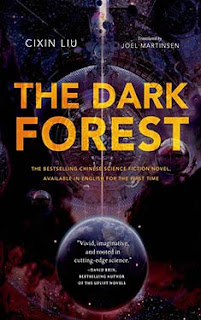The Dark Forest by Cixin Liu (Translated by Joel Martinsen)
Published: Tor (2015), first published in China in 2008
Series: Book 2 in the Three-Body Trilogy
This is the second book in a trilogy, beware of spoilers for the first book, Three-Body Problem!
The Book:
“Earth is reeling from the revelation of a coming alien invasion—in just four centuries' time. The aliens' human collaborators may have been defeated, but the presence of the sophons, the subatomic particles that allow Trisolaris instant access to all human information, means that Earth's defense plans are totally exposed to the enemy. Only the human mind remains a secret.
This is the motivation for the Wallfacer Project, a daring plan that grants four men enormous resources to design secret strategies, hidden through deceit and misdirection from Earth and Trisolaris alike. Three of the Wallfacers are influential statesmen and scientists, but the fourth is a total unknown. Luo Ji, an unambitious Chinese astronomer and sociologist, is baffled by his new status. All he knows is that he's the one Wallfacer that Trisolaris wants dead.” ~WWEnd.com
This is the second book I’ve read by Cixin Liu. I liked The Three-Body Problem, but I've been on the fence about continuing the trilogy for a while now.
The Book:
This trilogy really needs to be read in order, for reasons of plot rather than character. The events of The Dark Forest would be very confusing if you hadn’t already read The Three-Body Problem, but the main characters are mostly new. Among the new perspectives, there were none that really interested me as much as Ye Wenjie from the first novel, who lived through the Cultural Revolution. The character that receives the most focus, Luo Ji, I found kind of tiresome. Dealing with the impending Trisolaran invasion was mostly background noise for him, as he refined his idea of the perfect woman and tried to find her in reality. The other Wallfacers and the military guys were less tiresome in that respect, but not actually any more engaging.
The strength of the first novel was in its ideas, and here the ideas again take center stage. Humanity is facing eventual eradication by a species with far-superior technology, including an omniscient presence on Earth and the ability to block or direct our ability to progress in science as they see fit. I thought it was interesting to see how our governments might cope with a certain doom that is still a handful of human lifetimes away. It falls into that same temporal geologically-close-but-humanly-far-away niche, a bit like climate change in reality, that is really hard for us as a species to handle. I was surprised by how much effort went into managing morale, a project that seemed almost as significant as trying to find a solution. Regarding the possible solutions, the Wallfacer Project was a neat idea and a pleasant puzzle to try to unravel. I enjoyed seeing how much I had figured out by the time each participant’s true plans were revealed. As the novel moved away from our contemporary time period and into Earth’s future, I was fascinated by the new technology and the society that grew within the aliens’ imposed bounds on science.
Of course, if you’re thinking that the premise sounds kind of depressing, that’s because it is. Most of the characters struggled with knowing that not only they, but their entire species, were almost certainly going to die. The concept behind the title, “The Dark Forest”, is the bleakest answer to Fermi’s paradox I’ve ever read. This is not a book that has much positive to say about the nature of the human race, or that of any other sentient species. There is some small amount of hope from the Wallfacer Project, but I felt like most of the story was bogged down in despair. Emotionally, it was not always an easy book to read, even though I intellectually enjoyed some of the ideas. I am still planning to continue to the final volume, to see what happens next with the Trisolarans.
My Rating: 3 /5
The Dark Forest covers the depressing period between first contact with the Trisolaran civilization and their arrival to wipe out all human life with their superior technology. As in the first novel, the characters are not especially engaging, and the ideas are what hold the reader’s attention. This time, the story begins to move into the far future, imagining how technology would develop and how humans would cope with the long-term threat of eradication by a superior force. I enjoyed seeing the clever ways humanity tried to grapple with this problem, but the story had a bleakness that was a little overpowering at times.

No comments:
Post a Comment